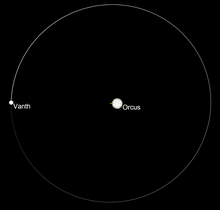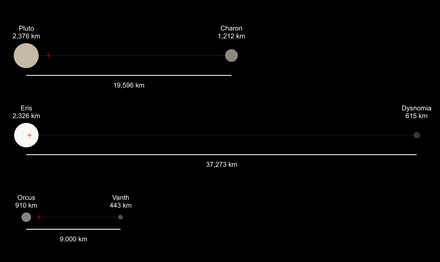Vanth (moon)
| Albedo | 0.08±0.02[7] |
|---|---|
| Temperature | <44 K[6]: 663 |
Spectral type | moderately red[11]: 2702 V–I = 1.03±0.05[11]: 2702 |
| 21.8[12] | |
| 4.88±0.05[11]: 2702 | |
Vanth (formal designation (90482) Orcus I;
Discovery
Vanth was discovered in
Name
Before Vanth was named, it had the
Vanth and Persipnei were among the few names that both matched the Etruscan origin and chthonic theme of Orcus's name, though Brown ultimately chose Vanth because its relationship to Orcus in Etruscan mythology strongly parallels the relationship between Pluto and Charon in Greek mythology.[17] In Etruscan iconography, Vanth is frequently portrayed in the company of Charun (the Etruscan counterpart of the Greek Charon), which alludes to the similar properties of the Pluto and Orcus systems (the latter being nicknamed the "anti-Pluto" because its orbital resonance with Neptune keeps it on the opposite side of the Sun from Pluto).[17] Brown quoted Taaffe as saying that if Vanth "accompanies dead souls from the moment of death to the underworld itself, then of course her face is turned always toward Orcus", a reference to the likely synchronous orbit of Vanth about Orcus.[17][18]
The submission for Vanth's name was assessed and approved by the IAU's Committee for Small Body Nomenclature,[e] in accordance with the naming procedures for minor planets and satellites.[19] The official naming citation was announced by the Minor Planet Center in a notice published on 30 March 2010.[3]: 350
Observability
Visual
From Earth, Vanth appears very close to Orcus with an
Occultations
Orbit

Vanth forms a
Vanth's orbit is inclined perpendicularly (90°) with respect to the plane of the Solar System. During the time Vanth was observed (2005–2023), the north pole of its orbit was pointed towards Earth such that Vanth's orbit appeared face-on or pole-on from Earth's perspective.[11]: 2700–2701 [8]: 4 The perspective of Vanth's orbital plane shifts very slowly as the Orcus–Vanth system travels along its 247-year orbit around the Sun.[4] Because of this slow shift in perspective, astronomers were not able determine Vanth's actual orbital inclination until 2015.[5]: 67 Vanth's orbit will eventually shift from a face-on to an edge-on perspective by the year 2082, after which the Orcus–Vanth system begins its season of mutual events where Orcus and Vanth take turns eclipsing and transiting each other.[5]: 67
Origin
The circular orbits and relative component sizes of the Orcus–Vanth system resembles the Pluto–Charon binary system, which led astronomers to suspect that these two systems formed and evolved similarly.
An impact origin of the Orcus–Vanth system would imply that both components should have similar densities, surface compositions, and colors.
Physical characteristics
Size, mass, and density

As of 2023[update], the most accurate estimate for Vanth's diameter is 443 ± 10 km (275 ± 6 mi), determined from a stellar occultation in 2017.[6]: 663, 665 [8]: 2 This estimate is consistent with the previous estimate of 475 ± 75 km (295 ± 47 mi) from thermal emission measurements by the Atacama Large Millimeter Array (ALMA) in 2016.[6]: 664 [7]: 2 Both estimates show that Vanth is roughly half of Orcus's diameter and is the third-largest known moon of a trans-Neptunian object, after Charon and Dysnomia.[7]: 3 [8]: 2
Vanth is massive enough that it gravitationally forces Orcus into orbit around the system's barycenter. High-resolution imaging by ALMA resolved Orcus's barycentric orbital motion in 2016, which showed that the barycenter lay 13.7%±1.3% along the separation distance from Orcus to Vanth.[8]: 4 This indicates Vanth has a mass of (8.7±0.8)×1019 kg.[f][8]: 4 The ratio of Vanth's mass to Orcus's mass is 16%±2%, which is greater than the Pluto–Charon binary's mass ratio of 12%.[8]: 5
Vanth appears to have a similar density as Orcus, despite there being large uncertainties in current estimates for Vanth's density.[8]: 5 According to ALMA measurements for Vanth's diameter and mass, Vanth's density is 1.5+0.5
−1.0 g/cm3.[8]: 4 Using the occultation estimate for Vanth's diameter instead of ALMA yields a higher density of 1.9±0.3 g/cm3.[c] If Vanth's density is indeed similar to Orcus's, this would support an impact origin for the system.[8]: 5 Nevertheless, additional observations of the Orcus–Vanth system are needed to refine Vanth's mass and density before any conclusions could be made about Vanth's origin and interior structure.[8]: 5
Surface
Visible and
Light curve, rotation, and shape
Due to the pole-on perspective of the Orcus–Vanth system from Earth, a large portion of the components' surfaces stay in view as they rotate, resulting in minuscule changes in brightness that make it difficult for astronomers to study the system's light curve.[11]: 2704 In addition, Orcus and Vanth orbit so close to each other that most telescopes on Earth cannot resolve them individually, so the light curves from each component are combined as a single light curve.[9]: 2 Continuous photometric observations of the unresolved Orcus–Vanth system in 2009–2010 showed that its overall brightness varies with a small light curve amplitude of 0.06±0.04 magnitudes and a period of 9.7±0.3 days.[9]: 3 This roughly coincides with Vanth's 9.54-day orbital period, which indicates there is synchronous rotation in one or both of the system's components.[9]: 3 At least one of these synchronously rotating components must have either an elongated shape or surface albedo variations to cause these brightness variations.[9]: 3 Researchers José Luis Ortiz et al. suggested in 2011 that at least Vanth must be synchronously rotating according to the Orcus–Vanth system's light curve,[9]: 3 whereas David Rabinowitz and Yasi Owainati argued in 2014 that the system's variability should most likely come from both components, meaning the Orcus–Vanth system should be doubly synchronous.[10]
No individually-resolved light curve for Vanth has been measured yet, so its shape is unknown.[6]: 663 Vanth's diameter lies close to the ~400 km (250 mi) threshold for hydrostatic equilibrium for the moons of Saturn and Uranus, so Vanth would probably not be massive enough to gravitationally compress itself into a sphere, especially in the cold temperatures of the Kuiper belt (below 44 K; −229 °C)[6]: 663 where ice and rock are more rigid.[25]: 75 [26]: 176
Notes
- ecliptic latitude of −0.54°±0.17°,[5]: 67 subtracting this angle from the ecliptic north pole of +90° gives the inclination with respect to the ecliptic: i = +90° – (–0.54°) = +90.54°.
- ascending node and argument of periapsis, so subtracting Vanth's ascending node of 53.49°±0.33° from its longitude of periapsis gives 274.51° for its argument of periapsis.
- ^ a b Brown and Butler (2023) did not calculate Vanth's density for its occultation-derived diameter of 442.5±10.2 km.[8]: 2 Using correct units, dividing Vanth's estimated mass of (8.7±0.8)×1019 kg by the spherical volume of the occultation-derived diameter gives a density of approximately 1.9±0.3 g/cm3.
- ^ In his blog posts, Michael Brown wrote Vanth's provisional designation as S/1 90482 (2005), which is a not a standard way of writing satellite provisional designations.[16][17]
- ^ The IAU's Committee for Small Body Nomenclature is now known as the Working Group Small Body Nomenclature.
- ^ two-body binary system, the ratio of the primary body's (Orcus) orbital radius (r1) from the barycenter to the system's separation distance (a) is equivalent to the ratio of the secondary's (Vanth) mass (m2) to the system's total mass (m1 + m2):
References
- ^ Bibcode:2007IAUC.8812....1B. Archivedfrom the original on 19 July 2011. Retrieved 4 July 2011.
- ^ Suer, Terry-Ann. "Publications". sites.google.com. Retrieved 11 July 2023.
- ^ a b "M. P. C. 69496" (PDF). Minor Planet Circulars (69496). Minor Planet Center: 350. 30 March 2010. Retrieved 8 August 2010.
- ^ a b c "JPL Small-Body Database Browser: 90482 Orcus (2004 DW)". Jet Propulsion Laboratory. Retrieved 14 July 2023.
- ^ S2CID 133585837.
- ^ S2CID 119099266.
- ^ S2CID 119343798. 164.
- ^ . 193.
- ^ S2CID 56051949. A31.
- ^ Bibcode:2014DPS....4651007R. 510.07.
- ^ S2CID 8864460.
- ^ a b c d Grundy, Will (21 March 2022). "Orcus and Vanth (90482 2004 DW)". www2.lowell.edu. Lowell Observatory. Retrieved 11 July 2023.
- ^ Bibcode:2005hst..prop10545B. Cycle 14. Retrieved 11 February 2023.
- Bibcode:2006hst..prop10860B. Cycle 15.
- Bibcode:2007hst..prop11169B. Cycle 16.
- ^ a b Brown, Michael E. (23 March 2009). "S/1 90482 (2005) needs your help". Mike Brown's Planets (blog). Archived from the original on 28 March 2009. Retrieved 25 March 2009.
- ^ a b c d e Brown, Michael E. (6 April 2009). "Orcus Porcus". Mike Brown's Planets (blog). Archived from the original on 14 April 2009. Retrieved 6 April 2009.
- ^ a b Taaffe, Sonya. "Vanth – The Naming of Vanth". sonyataaffe.com. Archived from the original on 15 January 2024. Retrieved 15 January 2024.
- ^ "Committee on Small Body Nomenclature: Names of Minor Planets". International Astronomical Union. 25 March 1999. Archived from the original on 29 January 2009. Retrieved 8 April 2009.
- ^ S2CID 118524500. A115.
- ^ "Occultation of TYC_5476-00882-1 by 90482 Orcus – 2014 March 01". Trans Tasman Occultation Alliance. Royal Astronomical Society of New Zealand. Retrieved 19 August 2023.
- ^ Guhl, Konrad (September 2017). "Beyond Jupiter: (90482) Orcus" (PDF). Journal for Occultation Astronomy. 7 (3): 15–16. Retrieved 18 July 2023.
- ^ S2CID 195366822.
- S2CID 118745903. A40.
- ISBN 9780977574032.
- .
External links
- Johnston, Wm. Robert (27 May 2019). "(90482) Orcus and Vanth". Asteroids with Satellites Database. Johnston's Archive.
- Lakdawalla, Emily (25 January 2018). "Some big moons in the Kuiper belt". The Planetary Society.



